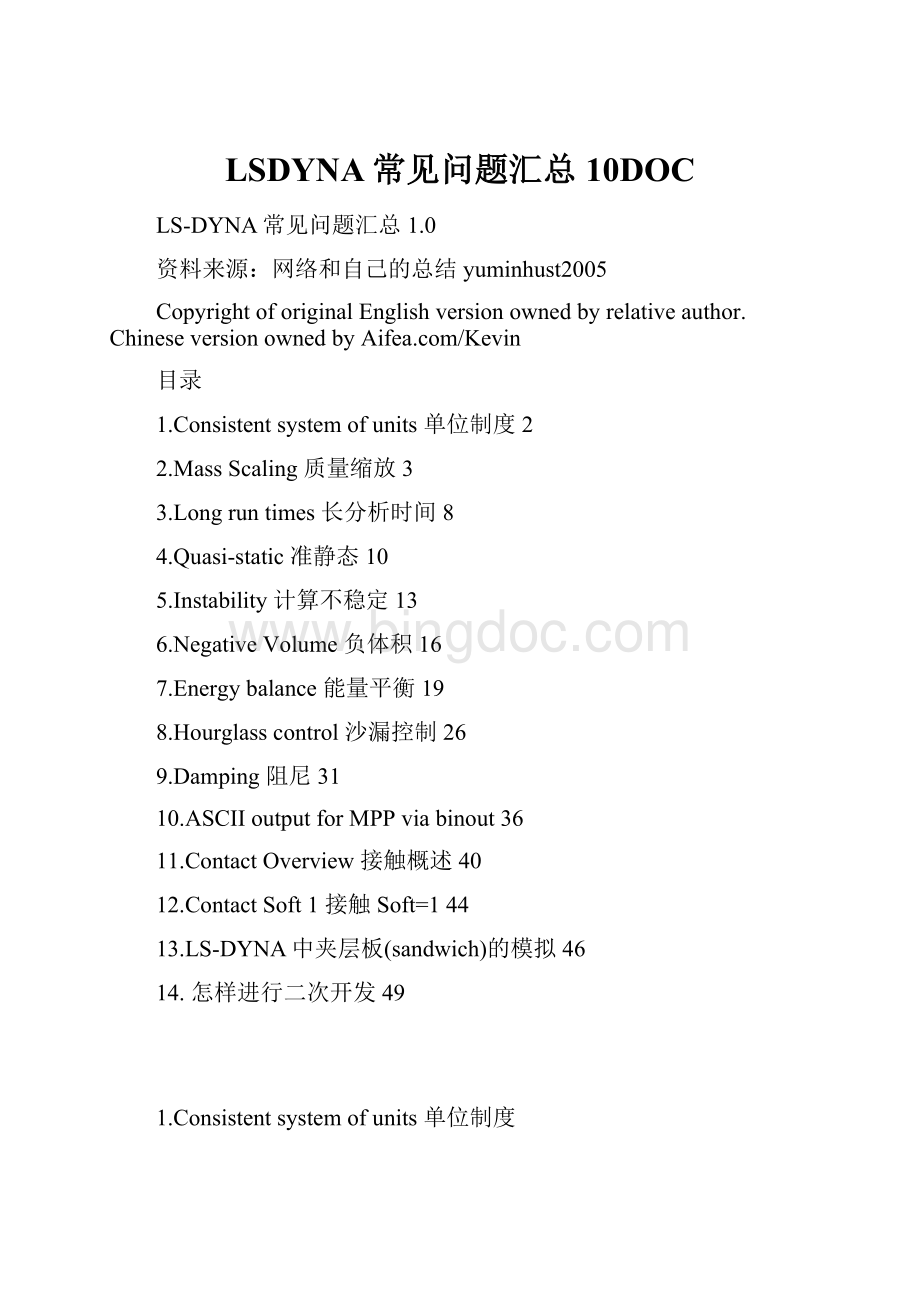LSDYNA常见问题汇总10DOC.docx
《LSDYNA常见问题汇总10DOC.docx》由会员分享,可在线阅读,更多相关《LSDYNA常见问题汇总10DOC.docx(46页珍藏版)》请在冰点文库上搜索。

LSDYNA常见问题汇总10DOC
LS-DYNA常见问题汇总1.0
资料来源:
网络和自己的总结yuminhust2005
CopyrightoforiginalEnglishversionownedbyrelativeauthor.ChineseversionownedbyA
目录
1.Consistentsystemofunits单位制度2
2.MassScaling质量缩放3
3.Longruntimes长分析时间8
4.Quasi-static准静态10
5.Instability计算不稳定13
6.NegativeVolume负体积16
7.Energybalance能量平衡19
8.Hourglasscontrol沙漏控制26
9.Damping阻尼31
10.ASCIIoutputforMPPviabinout36
11.ContactOverview接触概述40
12.ContactSoft1接触Soft=144
13.LS-DYNA中夹层板(sandwich)的模拟46
14.怎样进行二次开发49
1.Consistentsystemofunits单位制度
相信做仿真分析的人第一个需要明确的就是一致单位系统(ConsistentUnits)。
计算机只认识0&1、只懂得玩数字,它才不管你用的数字的物理意义。
而工程师自己负责单位制的统一,否则计算出来的结果没有意义,不幸的是大多数老师在教有限元数值计算时似乎没有提到这一点。
见下面LS-DYNAFAQ中的定义:
Definitionofaconsistentsystemofunits(requiredforLS-DYNA):
1forceunit=1massunit*1accelerationunit
1力单位=1质量单位×1加速度单位
1accelerationunit=1lengthunit/(1timeunit)^2
1加速度单位=1长度单位/1时间单位的平方
Thefollowingtableprovidesexamplesofconsistentsystemsofunits.
Aspointsofreference,themassdensityandYoung’sModulusofsteelareprovidedineachsystemofunits.“GRAVITY”isgravitationalacceleration.
MASS
LENGTH
TIME
FORCE
STRESS
ENERGY
DENSITY
YOUNG’s
Velocity(56.3KMPH)
GRAVITY
kg
m
s
N
Pa
Joule
7.83E+03
2.07E+11
15.65
9.806
kg
cm
s
1.e-02N
7.83E-03
2.07E+09
1.56E+03
9.81E+02
kg
cm
ms
1.e+04N
7.83E-03
2.07E+03
1.56
9.81E-04
kg
cm
us
1.e+10N
7.83E-03
2.07E-03
1.56E-03
9.81E-10
kg
mm
ms
KN
GPa
KN-mm
7.83E-06
2.07E+02
15.65
9.81E-03
gm
cm
s
dyne
dy/cm2
erg
7.83E+00
2.07E+12
1.56E+03
9.81E+02
gm
cm
us
1.e+07N
Mbar
1.e7Ncm
7.83E+00
2.07E+00
1.56E-03
9.81E-10
gm
mm
s
1.e-06N
Pa
7.83E-03
2.07E+11
1.56E+04
9.81E+03
gm
mm
ms
N
MPa
N-mm
7.83E-03
2.07E+05
15.65
9.81E-03
ton
mm
s
N
MPa
N-mm
7.83E-09
2.07E+05
1.56E+04
9.81E+03
lbfs2/in
in
s
lbf
psi
lbf-in
7.33E-04
3.00E+07
6.16E+02
386
slug
ft
s
lbf
psf
lbf-ft
15.2
4.32E+09
51.33
32.17
kgfs2/mm
mm
s
kgf
kgf/mm2
kgf-mm
8.02E-10
7.00E+02
1.56E+04
(Japan)
kg
mm
s
mN
1000Pa
7.83E-06
2.07E+08
9.81E+02
gm
cm
ms
100000Pa
7.83E+00
2.07E+06
2.MassScaling质量缩放
质量缩放指的是通过增加非物理的质量到结构上从而获得大的显式时间步的技术。
在一个动态分析中,任何时候增加非物理的质量来增大时间步将会影响计算结果(因为F=ma)。
有时候这种影响不明显,在这种情况下增加非物理的质量是无可非议的。
比如额外的质量只增加到不是关键区域的很少的小单元上或者准静态的分析(速度很小,动能相对峰值内能非常小)。
总的来说,是由分析者来判断质量缩放的影响。
你可能有必要做另一个减小或消除了质量缩放的分析来估计质量增加对结果的灵敏度。
你可以通过人工有选择的增加一个部件的材料密度来实现质量缩放。
这种手动质量缩放的方法是独立于通过设置*Control_timestep卡DT2MS项来实现的自动质量缩放。
当DT2MS设置为一个负值时,质量只是增加到时间步小于TSSFAC*|DT2MS|的单元上。
通过增加这些单元的质量,它们的时间达到TSSFAC*|DT2MS|。
有无数种TSSFAC和DT2MS的组合可以得到同样的乘积,因而有相同的时间步,但是对于每一种组合增加的质量将是不一样的。
一般的趋势是TSSFAC越小,增加的质量越多。
作为回报,当TSSFAC减小时计算稳定性增加(就像在没有做质量缩放的求解中一样)。
如果TSSFAC缺省的值0.9会导致稳定性问题,可以试试0.8或者0.7。
如果你减小TSSFAC,你可以相应增加|DT2MS|,这样还是可以保证时间步乘积不变。
为了确定什么时候和位置质量自动增加了,可以输出GLSTAT和MATSUM文件。
这些文件允许你绘出完整的模型或者单独部件所增加的质量对时间的曲线。
为了得到由壳单元组成的部件增加的质量云图,将*database_extent_binary卡的STSSZ项设置为3。
这样你可以用ls-prepost绘出每个单元的质量增加量的云图,具体方法是通过选择Fcomp>Misc>timestepsize。
在*control_timestep中设置DT2MS正值和负值的不同之处如下:
负值:
初始时间步将不会小于TSSFAC*-DT2MS。
质量只是增加到时间步小于TSSFAC*|DT2MS|的单元上。
当质量缩放可接受时,推荐用这种方法。
用这种方法时质量增量是有限的。
过多的增加质量会导致计算任务终止。
正值:
初始时间将不会小于DT2MS。
单元质量会增加或者减小以保证每一个单元的时间步都一样。
这种方法尽管不会因为过多增加质量而导致计算终止,但更难以作出合理的解释。
*control_timestep卡中的参数MS1ST控制是否只是在初始化时增加一次质量(MS1ST=1)还是任何需要维持由DT2MS所指定的时间步时都增加质量(MS1ST=0)。
你可以通过在*control_termination卡片中设置参数ENDMAS来控制当质量增加到初始质量一定比率时终止计算(只对自动质量缩放有效)
--------------------------
可变形点焊梁的质量缩放
*mat_spotweld卡的质量缩放参数DT只影响点焊单元。
如果*control_timestep卡中没有指定质量缩放(DT2MS=0),而且时间由可变形点焊控制,可以用参数DT来在初始化时增加惯量到点焊单元上来提高时间步达到DT指定的值。
当DT不为0时,增加到可变形点焊梁元上的质量会输出到d3hsp文件里。
MATSUM中动量和动能不受增加到可变形点焊上的质量的影响。
GSLTAT中DOES和总的KE受增加的质量的影响。
考虑三种调用可变形点焊的质量缩放的情况:
1.当DT2MS为负值*mat_spotweld卡DT=0时,尽管在d3hsp文件中可变形点焊质量增量百分比不真实。
下面几个值是正确的:
d3hsp中”addedspotweldmass”;第一个时间步之后的”addedmass”&“percentageincrease”;glstat和matsum中的”addedmass”。
2.当DT2MS为负值且*mat_spotweld卡DT≠0时,可变形点焊质量增加不会包含在d3hsp、glstat、matsum文件中的”addedmass”里。
这非常容易令人误解。
用户必须检查d3hsp文件的”addedspotweldmass”。
建议不要同时使用两种质量缩放标准,推荐使用第一种方法(即负的DT2MS&DT=0)。
3.如果DT2MS=0且DT≠0,初始时间步将不考虑增加点焊的质量,但是之后每一个周期时间步都会增加10%,直到时间步达到正确的值(考虑点焊质量增加)。
glstat&matsum不包含”addedmass”的行。
注意质量增加会引起能量比率增长。
EnglishVersion:
Mass-scalingreferstoatechniquewherebynonphysicalmassisaddedtoastructureinordertoachievealargerexplicittimestep.
Anytimeyouaddnonphysicalmasstoincreasethetimestepinadynamicanalysis,youaffecttheresults(thinkofF=ma).Sometimestheeffectisinsignificantandinthosecasesaddingnonphysicalmassisjustifiable.Examplesofsuchcasesmayincludetheadditionofmasstojustafewsmallelementsinanoncriticalareaorquasi-staticsimulationswherethevelocityislowandthekineticenergyisverysmallrelativetothepeakinternalenergy.Intheend,it’suptothejudgementoftheanalysttogagetheaffectofmassscaling.Youmayhavetoreduceoreliminatemassscalinginasecondruntogagethesensitivityoftheresultstotheamountofmassadded.
Onecanemploymassscalinginaselectivemannerbyartificiallyincreasingmaterialdensityofthepartsyouwanttomass-scale.ThismanualformofmassscalingisdoneindependentlyoftheautomaticmassscalinginvokedwithDT2MSin*control_timestep.
WhenDT2MSisinputasanegativevalue,massisaddedonlytothoseelementswhosetimestepwouldotherwisebelessthanTSSFAC*|DT2MS|.Byaddingmasstotheseelements,theirtimestepbecomesequaltoTSSFAC*|DT2MS|.AninfinitenumberofcombinationsofTSSFandDT2MSwillgivethesameproductandthusthesametimestepbuttheaddedmasswillbedifferentforeachofthosecombinations.ThetrendisthatthesmallertheTSSF,thegreatertheaddedmass.Inreturn,stabilitymayimproveasTSSFisreduced(justasinnon-mass-scaledsolutions).IfstabilityisaproblemwiththedefaultTSSFof0.9,try0.8or0.7.IfyoureduceTSSF,youcanincrease|DT2MS|proportionallysothattheproduct/timestepisunchanged.
Todeterminewhereandwhenmassisautomaticallyadded,writeGLSTATandMATSUMfiles.Thesefileswillallowyoutoplotaddedmassvs.timeforthecompletemodelandforindividualparts,respectively.Toproducefringeplotsofaddedmassinpartscomprisedofshellelements(DT2MSnegative),setSTSSZ=3in*database_extent_binary.Youcanthenfringetheaddedmass(perelement)usingLS-POSTbychoosingFcomp>Misc>timestepsize.(Here,thelabel“timestepsize”isreallytheelementaddedmass.)
ThedifferencebetweenusingapositiveornegativenumberforDT2MSin*control_timestepisasfollows:
Negative:
InitialtimestepwillnotbelessthanTSSF*-DT2MS.MassisaddedtoonlythoseelementswhosetimestepwouldotherwisebelessthanTSSF*abs(DT2MS).Whenmassscalingisappropriate,Irecommendthismethod.Theamountofmassthatcanbeaddedusingthismethodislimited.‘Excessive’addedmasswillcausethejobtoterminate.
Positive:
InitialtimestepwillnotbelessthanDT2MS.MassisaddedORTAKENAWAYfromelementssothatthetimestepofeveryelementisthesame.Thismethodishardertorationalizealthoughitisnotsubjecttoterminationfrom‘excessive’addedmass.
TheparameterMS1STin*control_timestepcontrolswhethermassisaddedonlyonceduringinitialization(MS1ST=1)oranytimeasnecessarytomaintainthedesiredtimestepspecifiedviaDT2MS(MS1ST=0).
YoucanuseENDMASin*control_terminationtostopthecalculationafteracertainamountofmasshasbeenadded(activeforautomaticmassscalingonly).
_____________________________________________________________________
Mass-scalingofdeformablespotweldbeams:
Themass-scalingparameterin*mat_spotweld(DT)affectsonlythespotwelds.Ifnomass-scalingisinvokedin*control_timestep(DT2MS=0.)ANDthetimestepiscontrolledbythedeformablespotwelds,DTcanbeusedtoaddinertiatothespotweldsduringintializationinordertoincreasethetimesteptoavalueofDT.WhenDTisnonzero,massaddedtospotweldbeamsisreportedtod3hsp.MATSUMmomentumandKEdoesNOTfactorinaddedmasstodef.spotwelds.GLSTATDOESfactorinaddedmasstototalKE(spotweld.beam.type9.mscale.initvel.k)
Consider3casesofinvokingmass-scalinginamodelwithdeformablespotwelds:
1.Although“percentagemassincrease”under“DeformableSpotwelds:
”ind3hspisboguswhenDT2MSisneg.andDTin*mat_spotweld=0,thefollowingarecorrect:
“addedspotweldmass”ind3hsp
“addedmass”and“percentageincrease”ind3hspAFTERthefirsttimestep
“addedmass”inglstatandmatsum
2.AddedspotweldmasscontrolledbyDTin*mat_spotweldisNOTINCLUDEDin“addedmass”givenind3hsp,glstat,ormatsumwhenDT2MSisneg.andDTin*mat_spotweldisnonzero.Thiscanbequitemisleading.Usermustcheckfor“addedspotweldmass”ind3hsp.Recommended:
Donotinvokebothmass-scalingcriteria.Neg.DT2MSwithDT=0(case1above)ispreferred.
3.IfDTisnonzeroandDT2MS=0,theinitialtimestepwillNOTconsideraddedspotweldmassbutthetimestepwillincreaseby10%eachcycleuntilthecorrecttimestep(consideringaddedspotweldmass)isachieved.Glstatandmatsumcontainno“addedmass”lineitem.
Theabovecanbeillustratedusing/j5000a_2/jday/test/weld/spotweld.beam.type9.mscale.k.
_____________________________________________________________________
Notethataddedmassmaycausetheenergyratiotorise.
(See/j5000a_2/jday/test/erode/taylor.mat3.noerode.mscale.k)
3.Longruntimes长分析时间
当用显式时间积分时,对于仿真非常小的部件而分析时间又要相当长时没有好的方法。
质量缩放(mass-scaling)增加了需要确认非物理质量的增加不会显著影响计算结果的负担。
当使用时间缩放(time-scaling)时也有同样的问题。
时间缩放(time-scaling)是指为了减小需要的时间步数,通过增加加载速率而缩短仿真时间。
要确认时间步不是仅由很少的小单元或者刚度大单元控制,可以通过在d3hsp文件中搜索”smallest”来显示100个最小的时间步单元。
如果只有很少的几个单元控制时间步,可以把那些单元及邻近区域重新remesh或者把它们变成刚体。
可是仅运行必要长的时间是很明显的。
这意味着在一个跌落分析的情况时,给跌落物体一个初速度,把它放在离地面一个非常小的距离。